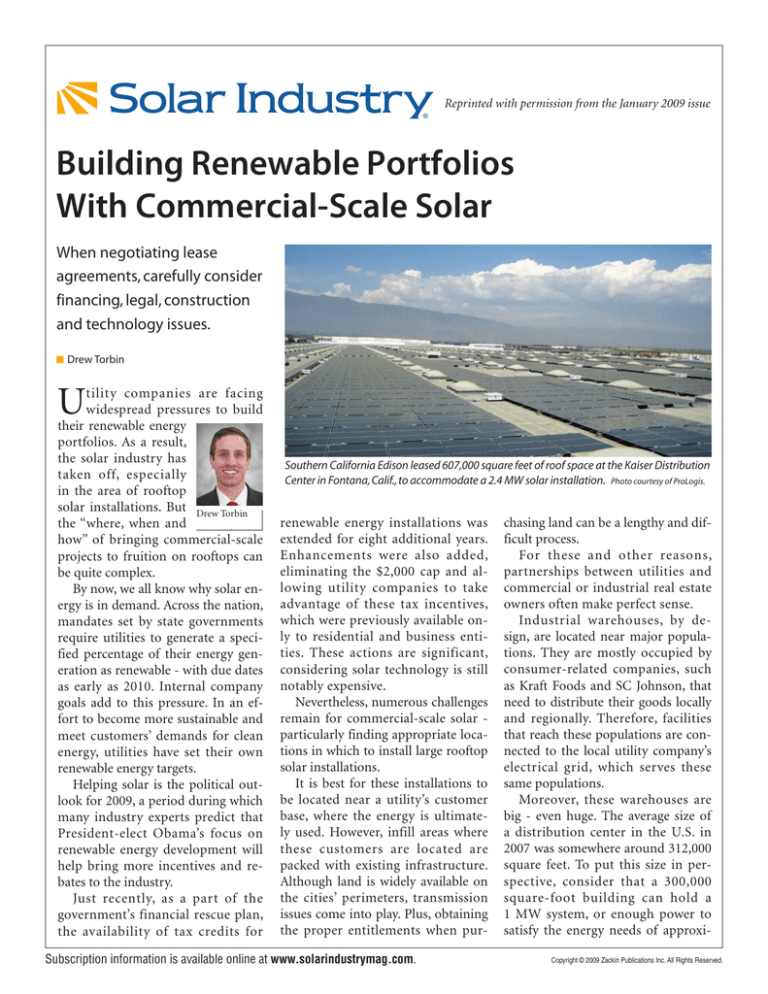
Reprinted with permission from the January 2009 issue
Building Renewable Portfolios
With Commercial-Scale Solar
When negotiating lease
agreements, carefully consider
financing, legal, construction
and technology issues.
b Drew Torbin
U
tility companies are facing
widespread pressures to build
their renewable energy
portfolios. As a result,
the solar industry has
taken off, especially
in the area of rooftop
solar installations. But Drew Torbin
the “where, when and
how” of bringing commercial-scale
projects to fruition on rooftops can
be quite complex.
By now, we all know why solar energy is in demand. Across the nation,
mandates set by state governments
require utilities to generate a specified percentage of their energy generation as renewable - with due dates
as early as 2010. Internal company
goals add to this pressure. In an effort to become more sustainable and
meet customers’ demands for clean
energy, utilities have set their own
renewable energy targets.
Helping solar is the political outlook for 2009, a period during which
many industry experts predict that
President-elect Obama’s focus on
renewable energy development will
help bring more incentives and rebates to the industry.
Just recently, as a part of the
government’s financial rescue plan,
the availability of tax credits for
Southern California Edison leased 607,000 square feet of roof space at the Kaiser Distribution
Center in Fontana, Calif., to accommodate a 2.4 MW solar installation. Photo courtesy of ProLogis.
renewable energy installations was
extended for eight additional years.
Enhancements were also added,
eliminating the $2,000 cap and allowing utility companies to take
advantage of these tax incentives,
which were previously available only to residential and business entities. These actions are significant,
considering solar technology is still
notably expensive.
Nevertheless, numerous challenges
remain for commercial-scale solar particularly finding appropriate locations in which to install large rooftop
solar installations.
It is best for these installations to
be located near a utility’s customer
base, where the energy is ultimately used. However, infill areas where
these customers are located are
packed with existing infrastructure.
Although land is widely available on
the cities’ perimeters, transmission
issues come into play. Plus, obtaining
the proper entitlements when pur-
Subscription information is available online at www.solarindustrymag.com.
chasing land can be a lengthy and difficult process.
For these and other reasons,
partnerships between utilities and
commercial or industrial real estate
owners often make perfect sense.
Industrial warehouses, by design, are located near major populations. They are mostly occupied by
consumer­- related companies, such
as Kraft Foods and SC Johnson, that
need to distribute their goods locally
and regionally. Therefore, facilities
that reach these populations are connected to the local utility company’s
electrical grid, which serves these
same populations.
Moreover, these warehouses are
big - even huge. The average size of
a distribution center in the U.S. in
2007 was somewhere around 312,000
square feet. To put this size in perspective, consider that a 300,000
square-foot building can hold a
1 MW system, or enough power to
satisfy the energy needs of approxiCopyright © 2009 Zackin Publications Inc. All Rights Reserved.
An artist’s rendering of a portion of a 1.1 MW solar installation at a distribution center
in Portland, Ore. Courtesy of ProLogis.
mately 1,000 houses for a year - or
perhaps more, depending on the
technology used.
The design of these warehouses
often benefits solar installations: The
roofs are very flat, and they sit slightly
lower than the exterior walls of the
warehouse, making installations viewable only from an aerial perspective.
Construction does not harm the
community, and security is enhanced
by the location, which prevents possible vandalism or theft both during
construction and over the life of the
power-generating installation.
The best aspect of utilizing a
warehouse roof for solar installations
may be that the building is immediately available. It is already properly
entitled, and no capital needs to be
spent by the utility for purchasing
land. The owner of the industrial
facility has existing site control as
well as a long-term vested interest in
the property. Thus, power can begin
to be generated on a near-term basis - in as little as 90 days in the most
ideal situations.
Environmentalists appreciate
rooftop solar because the installations do not take up greenfields
(land that has not yet been touched
by development).
Additionally, from a technical
standpoint, rooftop solar installations are also more stable on a commercial scale because utilities are
able to harness the benefits of a
distributed generation technique,
making the aggregate system more
resilient in case of outages or other
potential disruptions. In short, the
power is generated in a place where
the users are located during peak
usage times, with minimal need to
increase transmission capability.
There are obvious benefits to utilizing large rooftops for solar installations, but utilities can find additional value in working with real estate
partners that understand the goals
and objectives of the power generator and can meet project timelines.
The following describes what a utility
needs to know to make projects like
this work, and what it should look for
in a real estate partner.
Utility responsibilities
In 2008, our company partnered
with two large utilities - Southern
California Edison (SCE) and Portland
General Electric (PGE) - for rooftop solar installations. When pursuing projects like these, each partner
should leverage its core competencies
to reduce the chances of overcommitting resources or making mistakes.
Subscription information is available online at www.solarindustrymag.com.
Commercial real estate owners
are experienced at leasing space and
are skilled at construction management. Utilities, on the other hand,
are experienced in owning energygenerating assets, meeting their customers’ needs and knowing how best
to meet their energy requirements.
Therefore, deal structuring matters. Beyond utilizing their core
competencies, real estate owners
may also be interested in leasing the
roof area, because they gain additional income from an existing asset.
They maintain a long-term interest
in the property, and their customers
inside the building also benefit from
additional insulation on the roof,
which helps reduce the cost of cooling and heating.
The building owner is also likely
experienced in construction and is
certainly intimately familiar with its
own buildings, including structural elements of each facility and how
much load a particular roof can take.
In addition, real estate owners have
existing relationships with the architects that designed the facilities, as
well as with contractors in the area
that can best complete the project in
the necessary time frame and for the
appropriate price.
On the other hand, it is advantageous for the utility to own and operate the solar installation. This way,
the utility is able to help fund the
project through its rate base, which
can limit the exposure a project has
to the current credit crisis.
As previously mentioned, many
utilities are now able to take advantage of government-related subsidies and tax incentives. It is also in
the utility’s best interest to maintain
ownership of the system so that it
can control maintenance and general
repairs. The system is, after all, being
used to serve its customers.
Negotiating the transaction
When negotiating rooftop lease
agreements, both sides must carefully
consider financing arrangements, leCopyright © 2009 Zackin Publications Inc. All Rights Reserved.
Workers install thin-film solar panels at ProLogis Park PDX in Portland, Ore. Photo courtesy of ProLogis.
gal requirements, construction techniques and technology selection.
Financing arrangements can make
or break the deal. In today’s market, it makes sense to align with a
business partner that has a lasting
reputation. Lenders like to know that
participation includes established
companies that have experience with
related, successful projects.
In some instances, major real estate companies even have an investment management component to
their business, thus providing connections to other sources of capital.
Because each side wants to ensure
that its best interests are represented,
legal requirements in the agreements
between real estate partners and utilities can be quite involved. Having
a real estate partner that has leased
roof space previously is a real benefit
and will help eliminate any guesswork that may come by nature of
these arrangements. Partnering with
an experienced site host will also pay
dividends throughout the construction period and operational life of
the project.
As mentioned previously, real estate owners have intimate knowledge
of their buildings and the contractors
in local markets. They should, however, also bring knowledge of the best
technology needed for a particular
location.
Choosing the wrong technology
has the potential to be a major dealbreaker. For example, our project
with PGE is located in an area with
high wind conditions and heavy
snow loads. After lengthy consideration, our team decided on building­i ntegrated thin-film solar panels,
which are laid flush against the roof
material, leaving it nearly impossible
for weather-related damage to occur.
Having a partner that has this expe-
Subscription information is available online at www.solarindustrymag.com.
rience is paramount and ensures the
investment is protected.
Support from local government
organizations and the community
is essential as well. With a real estate
partner that is active in a particular market, the deals come together smoothly and swiftly because of
their existing relationships. For example, in our transaction with SCE,
we already had working relationships with government officials in
Southern California and were able
to fast-track permits.
The best real estate partner for the
utility is a company that can negotiate all of the needed relationships
and hurdles associated with pulling
these rooftop projects together. This
ability is the biggest help of all.
The time is right to accelerate the
fight against global warming and promote energy independence. If carefully planned, business relationships
between utility companies and real
estate companies can launch successful solar projects that bring us closer
to those goals - rooftop by rooftop. S
Drew Torbin is manager of sustainability for
ProLogis, an owner, manager and developer
of distribution facilities worldwide. Torbin,
who is involved in renewable energy implementation, carbon management, sustainability reporting and energy efficiency measures,
can be reached at atorbin@prologis.com.
Copyright © 2009 Zackin Publications Inc. All Rights Reserved.


